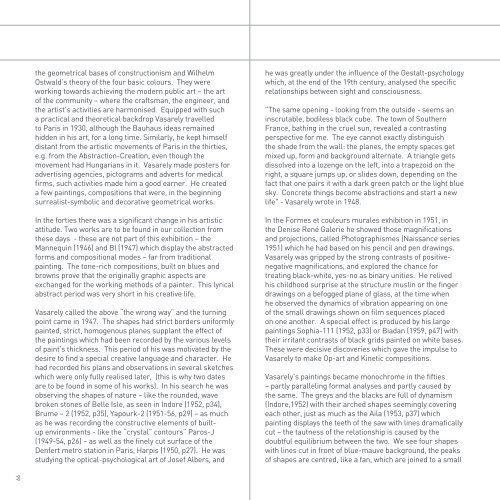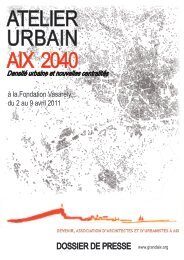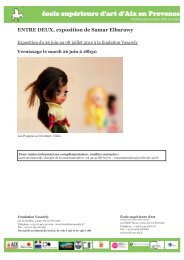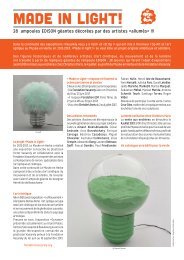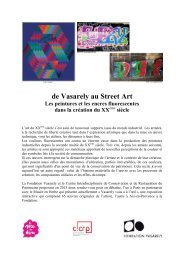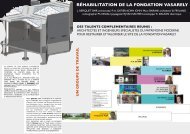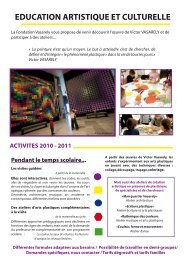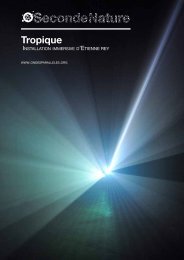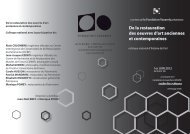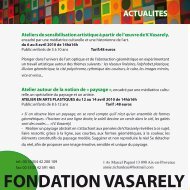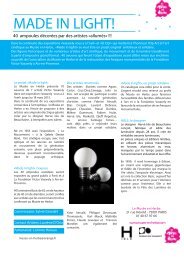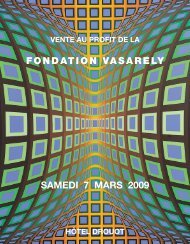Victor Vasarely - Fondation Vasarely
Victor Vasarely - Fondation Vasarely
Victor Vasarely - Fondation Vasarely
Create successful ePaper yourself
Turn your PDF publications into a flip-book with our unique Google optimized e-Paper software.
66<br />
the geometrical bases of constructionism and Wilhelm<br />
Ostwald’s theory of the four basic colours. They were<br />
working towards achieving the modern public art – the art<br />
of the community – where the craftsman, the engineer, and<br />
the artist’s activities are harmonised. Equipped with such<br />
a practical and theoretical backdrop <strong>Vasarely</strong> travelled<br />
to Paris in 1930, although the Bauhaus ideas remained<br />
hidden in his art, for a long time. Similarly, he kept himself<br />
distant from the artistic movements of Paris in the thirties,<br />
e.g. from the Abstraction-Creation, even though the<br />
movement had Hungarians in it. <strong>Vasarely</strong> made posters for<br />
advertising agencies, pictograms and adverts for medical<br />
firms, such activities made him a good earner. He created<br />
a few paintings, compositions that were, in the beginning<br />
surrealist-symbolic and decorative geometrical works.<br />
In the forties there was a significant change in his artistic<br />
attitude. Two works are to be found in our collection from<br />
these days - these are not part of this exhibition – the<br />
Mannequin (1946) and BI (1947) which display the abstracted<br />
forms and compositional modes – far from traditional<br />
painting. The tone-rich compositions, built on blues and<br />
browns prove that the originally graphic aspects are<br />
exchanged for the working methods of a painter. This lyrical<br />
abstract period was very short in his creative life.<br />
<strong>Vasarely</strong> called the above “the wrong way” and the turning<br />
point came in 1947. The shapes had strict borders uniformly<br />
painted, strict, homogenous planes supplant the effect of<br />
the paintings which had been recorded by the various levels<br />
of paint’s thickness. This period of his was motivated by the<br />
desire to find a special creative language and character. He<br />
had recorded his plans and observations in several sketches<br />
which were only fully realised later, (this is why two dates<br />
are to be found in some of his works). In his search he was<br />
observing the shapes of nature – like the rounded, wave<br />
broken stones of Belle Isle, as seen in Indore (1952, p34),<br />
Brume – 2 (1952, p35), Yapourk-2 (1951-56, p29) – as much<br />
as he was recording the constructive elements of builtup<br />
environments - like the “crystal” contours” Paros-J<br />
(1949-54, p26) – as well as the finely cut surface of the<br />
Denfert metro station in Paris, Harpis (1950, p27). He was<br />
studying the optical-psychological art of Josef Albers, and<br />
he was greatly under the influence of the Gestalt-psychology<br />
which, at the end of the 19th century, analysed the specific<br />
relationships between sight and consciousness.<br />
"The same opening - looking from the outside - seems an<br />
inscrutable, bodiless black cube. The town of Southern<br />
France, bathing in the cruel sun, revealed a contrasting<br />
perspective for me. The eye cannot exactly distinguish<br />
the shade from the wall: the planes, the empty spaces get<br />
mixed up, form and background alternate. A triangle gets<br />
dissolved into a lozenge on the left, into a trapezoid on the<br />
right, a square jumps up, or slides down, depending on the<br />
fact that one pairs it with a dark green patch or the light blue<br />
sky. Concrete things become abstractions and start a new<br />
life" - <strong>Vasarely</strong> wrote in 1948.<br />
In the Formes et couleurs murales exhibition in 1951, in<br />
the Denise René Galerie he showed those magnifications<br />
and projections, called Photographismes (Naissance series<br />
1951) which he had based on his pencil and pen drawings.<br />
<strong>Vasarely</strong> was gripped by the strong contrasts of positivenegative<br />
magnifications, and explored the chance for<br />
treating black-white, yes-no as binary unities. He relived<br />
his childhood surprise at the structure muslin or the finger<br />
drawings on a befogged plane of glass, at the time when<br />
he observed the dynamics of vibration appearing on one<br />
of the small drawings shown on film sequences placed<br />
on one another. A special effect is produced by his large<br />
paintings Sophia-111 (1952, p33) or Biadan (1959, p47) with<br />
their irritant contrasts of black grids painted on white bases.<br />
These were decisive discoveries which gave the impulse to<br />
<strong>Vasarely</strong> to make Op-art and Kinetic compositions.<br />
<strong>Vasarely</strong>’s paintings became monochrome in the fifties<br />
– partly paralleling formal analyses and partly caused by<br />
the same. The greys and the blacks are full of dynamism<br />
(Indore,1952) with their arched shapes seemingly covering<br />
each other, just as much as the Aila (1953, p37) which<br />
painting displays the teeth of the saw with lines dramatically<br />
cut – the tautness of the relationship is caused by the<br />
doubtful equilibrium between the two. We see four shapes<br />
with lines cut in front of blue-mauve background, the peaks<br />
of shapes are centred, like a fan, which are joined to a small


